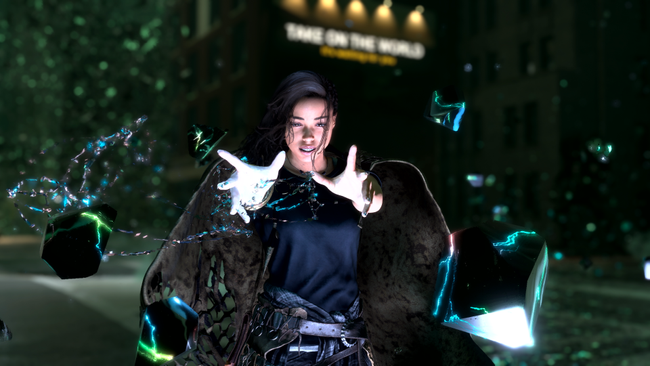
Forspoken’s demo showcases combat with deep potential, but poor tutorials do it no favors
Forspoken is a grower. That’s what I’ve learned from the game’s new demo, which was announced and released during Thursday’s action packed Game Awards ceremony.
It’s also very much a successor to Final Fantasy XV. There’s a lineage of technology and development staff between the two games - and you can tell. It’s difficult to fully articulate in words, but there’s something about the way Forspoken protagonist Frey Holland moves - from her stubby normal jump to a sluggish general ‘feel’, largely caused by prioritizing animation over responsiveness, that reminds of Noctis.
Indeed, at first blush, a lot of this stuff seems to stand against Forspoken, rather than for it. Like, it’s another game from the FF15 team, but without that Final Fantasy sparkle and fan service, but retaining some of the less desirable traits of that game? Well, great. But then, like I said, it grows.
It grows, in most part, thanks to a truly fantastic traversal system and combat mechanics that are just satisfying to use. Forspoken is built around magic, and though the spells it starts you with are relatively rudimentary, there’s enough to unlock and explore in the demo that can give you a really strong idea of how this combat system can grow into something a little more special.

It’s got one of my favorite things to see in RPGs, which is just a series of mechanical systems and abilities that can lock together in interesting ways. I really like Crucible, which creates a raging ring of fire, giving Frey an attack buff if she and enemies are fighting inside it, for instance. Also, the traversal skills which make exploring this world so fun - magical parkour, if you will - sort of fold back into combat in interesting ways.
It all looks chaotic, and feels like a very suitable continuation of how you’d hold down a single button and Noctis would teleport around, switch weapons, and generally look cool in FF15. But like FF15, players who put the effort in can definitely exert a higher degree of direct control if they want, which is where the game begins to feel more explicitly satisfying.
But, sadly, I feel like few who play this demo will reach that status - and it might do more harm than good. The way this demo is set up and the way it tutorializes Forspoken’s systems is nothing short of embarrassing. I doubt this is how the tutorials will be in the final game, but I fear that somebody on the fence or clueless about this game will start the demo, fiddle around for a few minutes, and quit out - without seeing practically any of the cool stuff.
This is the sort of demo that works fine for media, who see unfinished builds with practically no direction for players all the time. It’d also work at a show, where people might play it for ten minutes on a pod and leave understanding that there’s more to learn. For a home download demo, though, you really need to present a similar experience to starting the game for real as you can, or else it might do more harm than good.
Unfortunately, I fear that’s what’s happening here: a glance at prominent games forums, or on social media, reveals a fair split of people who’ve put the time in expressing passion for the game’s combat, and people disappointedly talking of canceling pre-orders.
There are, of course, other problems with Forspoken laid bare in this demo, but I’d call them teething problems for a new franchise rather than disastrous. The way the game uses HDR is eye-searingly aggressive, for instance, and it can be easy to lose track of what’s happening, such is the visual excessiveness of the game’s combat. It’s in this, by the way, that it most emits that tech demo energy I wrote about last year - where it can sometimes feel more like one of those Unreal or Nvidia tech demos come to life rather than an actual balanced, curated video game. But also, you sort of get used to the excess after a while and learn to navigate it. I have to admit, the excess sometimes does look great, too. Speaking of excess - that UI is too much and is frequently terrible.
Also, and finally - if you have to offer an option to toggle off your painstakingly written and recorded quippy dialogue… maybe there’s too much of it? I’m all for toggles and options in games, but this one feels like a cowardly bit of design. Rather than try to find an appropriate amount and tweak to reach it, Forspoken's chatter is just left at ludicrous levels - too much - with players given the option to turn it off when (not if) it becomes annoying. If you’re proud of that dialogue, you want players to hear at least some of it. There’s a middle ground here, but Forspoken seemingly isn’t interested in finding it.
I'd categorize all this as relatively small, however - especially in a new franchise that is trying to find its identity and feet. These are the sorts of things that can be largely overlooked in favor of killer combat or moreish travesal; both of which Forspoken is angling towards.
So… Forspoken appears to be a game of ups and downs. I feel like some of this, like how the game teaches its systems, will inevitably be better in the final release. Other stuff is clearly by design. There’s good ideas here, though - the kernel of a new series with systems that could blossom into something special.
One wonders if a poorly-pitched demo that doesn’t put its best foot forward could jeopardize that. Hopefully not. I look forward to the full version next month.